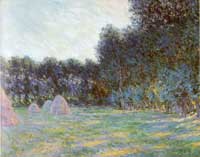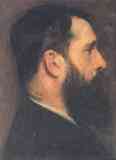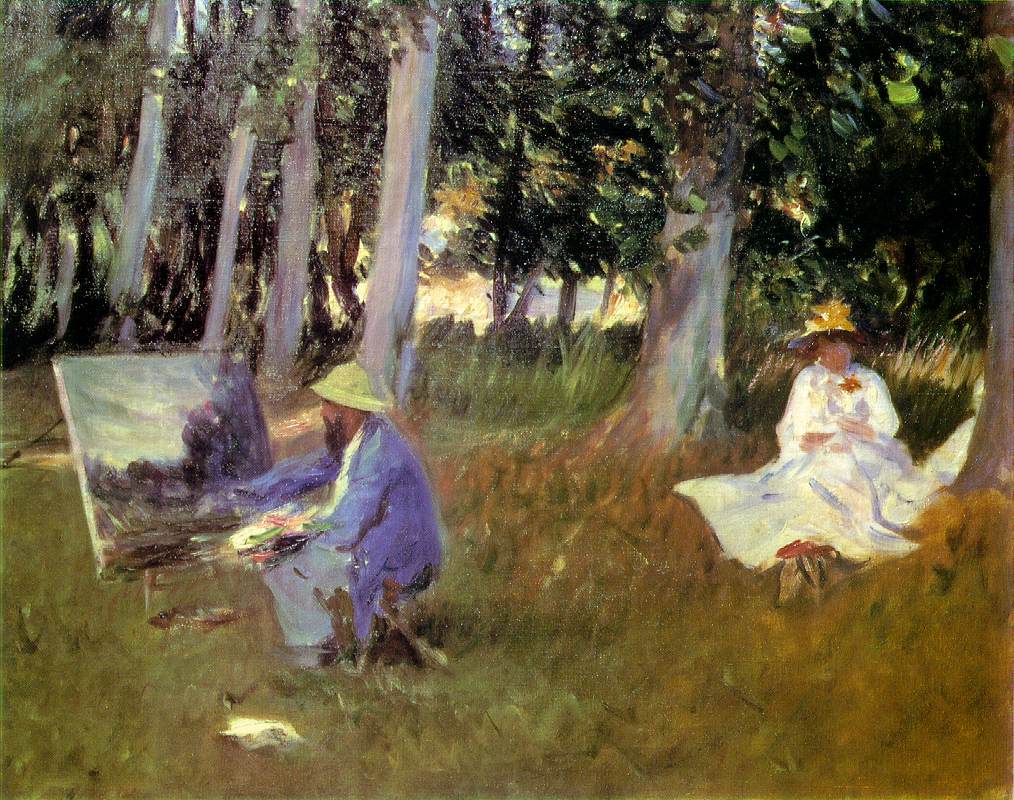Claude
Monet Painting
John
Singer Sargent
-- American painter
1885? [1]
Tate
Gallery, London
Oil on
canvas
54 x
64.8 cm (21 1/4
x 25 1/5 in.)
Presented
by Miss Emily
Sargent and Mrs Ormond through the National Art Collections Fund 1925
N04103
Jpg: Tate
Gallery, London
When Sargent
arrived in Paris to
formally study painting in 1874, it was the same year of the Monet was
showing at the Exhibition
of Independents and was nine years after the scandalous exhibition
of Edouard Manet's Olympia. By 1885-1887 (as the exact date of
this painting is in question) the Impressionist moment was in full
swing. Though John refused
to
wed himself in total to the Impressionist, his heart was clearly
excited
by the revolutionary implication and changes that impressionism
brought.
Although he did not
join them, in
his private moments and when he was painting for himself or friends
such
as this painting: Claude Monet Painting, he simply loved
impressionism and he
simply
loved painting in Plein Air.
 |


Meadow with Haystacks
near Giverny
1885

|
This
particular painting shows Monet working on what is
thought to be Monet's "Meadow with
Haystacks near Giverny" which, if that
is correct and if Monet's painting is dated right, pretty clearly pegs
the date of Sargent's painting. A juxtapotition
of the two shows
strong similarities. Resting behind Monet on the grass may be Alice
Hoschedé (painted
by Carolus-Duran
in 1878) whom had been living
with Claude Monet as a couple after
she left her husband Ernest Hoschedé. The two would eventually
be married in '92, a year after her husband's eventual death.
* * *
For Sargent, these
Impressionist influences along with his
close
friendship with Monet and others effected how he viewed the art of
portraiture
and for the longest time the British thought his work far too "French".
It wasn't really until the Americans embraced him that he began to once
again gain notice in England.
Some time around
1911, Fredreck Jameson
wrote a book on Modern Art which included, of course, Monet. Sargent
having
read the book was was quick to comment. He simply hated talking about
his
own work and preferred it to just stand on its own and without comment.
However, Sargent was always ready to defend his friends' art and loved
to discuss it at great length with others and he commented in a letter
to the author since it concerned, at least in part, his dear friend
Monet.
31,
Trite Street
Chelsea,
S.W
March 20th
(1911 or 1912)
My dear
Jameson,
I have been
reading your book
with great enjoyment, and feel as if my ideas and my vocabulary had
gone
through a very satisfactory spring cleaning and I like the opposition
of
your clear processes of reasoning and analysis as far as that will take
one and the ultimate mystery that you lead one up to form the different
directions.
There is
one point only that
I should quibble at and that is your use of the word Impressionism and
Impressionist.
These words
were coined in
Paris at a particular moment when Claude Monet opened the eyes of a few
people to certain phenomena of optics, and they have a very precise
meaning
which is not the one that you use them for, so that in the exact sense
or to the Frenchman Watt's saying "All art is Impressionism" would be a
misuse of the words.
"Impressionism"
was the name
given to a certain form of observation when Monet not content with
using
his eyes to see what things were or what they looked like as everybody
had done before him, turned his attention to noting what took place on
his own retina (as an oculist would test his own his own vision).
It led to
his doing 50 pictures
of the same subject under varying degrees of light and the phenomena
which
he recorded would be more or less apparent when there was excess or
deficiency
of light and the fact that he is astigmatic accounts for his having an
excellent subject for his own discoveries in this line.
A person
with normal eyesight
would have nothing to know in the way of "Impressionism" unless he were
in a blinding light or in the dusk or dark.
If you want
to know what an
impressionist tries for (by the way Degas said there is only one
Impressionist
"Claude Monet") go out of doors and look at the landscape with the sun
in your eyes and alter the angle of your hat brim and notice the
difference
of colour in dark objects according to the amount of light you let into
your eyes -- you can vary it from the local colour of the object (if
there
is less light) to something entirely different which is an appearance
on
your own retain when there is too much light.
It takes
years to be able to
notice this accurately enough for painting purposes and it would only
seem
worth while to people who would wear the same glasses as the
painter
and then it has the effect of for the first time coming across a
picture
that looks like nature and gives the sense of living -- for these
reasons
Monet bowled me over -- and he counts as having added a new perception
to Artists as the man did who invented perspective.
This
observation or faculty
does not make a man an Artist any more than the knowledge of
perspective
does -- it is nearly a refining of one's means towards representing
things
and one step further away from the hieroglyph by adding to the
representation
of a thing the conscious Will of Medium through which one sees it.
One of
these days some genius
will turn it to account and make it part of the necessary equipment of
an Artist.
For the
present in its exact
sense "impressionism" does not come within the scope of your
considerations.
Of course I agree with what you say, give the rough and tumble and
un-Jameson
like use of the word.
You can
make impression stand
for whatever you like but not add -sm or -ist without being challenged
by the astigmatic.
Yours
sincerely,
John S.
Sargent.
(letter to Jameson,
Charteris ,
P123-124)
When Evan Charteris
was preparing his
biography on Sargent, he sent a copy of JSS's letter to Monet
requesting
confirmation of Sargent's views. It should be noted when you read
Monet's
response that a literal reading without the delicate understanding of a
gentleman's modesty might lead to a wrong impression -- for though he
dose
not "approve" of John's views, he likewise does not refute them.
To
Evan Charteris
June 21, 1926
Dear Sir,
Forgive me
for not having replied
earlier but I am still not very well and still can not write to you
myself.
Furthermore,
I can only confirm
what i told you in our last interview. After having carefully reread
your
letter and the copy of the one from Sargent, I admit that if the
translation
of Sargent's letter is accurate, I can not approve it, firstly because
he makes me out to be greater than I am, then because I have always
felt
a horror of theories, and lastly because all I have is the merit of
having
painted directly from nature, while trying to pin down my impressions
before
the most fleeting of effects, and I am very sorry to have been the
cause
of a name given to a group the majority of which had nothing to do with
Impressionism.
With all my
regrets at not
having been able to give you complete satisfaction, I remain yours
sincerely,
Claude Monet
Letter to
Evan Charteris
(The Impressionists
and Their Legacy,
Barns & Nobel Books, P. 320)
From: Tate
Gallery Display Caption
(08-Aug-2001)
Sargent first met
Monet in 1876,
but the two artists were closest ten years later. It was probably in
1885
that they painted together at Giverny, near Paris. Sargent admired the
way that Monet worked out of doors, and imitated some of his subjects
and
methods in sketches such as this. It is characteristic of Sargent to
give
a human view of Monet’s practice and of the patience of his wife, who
sits
behind him. When he settled in London in 1885 Sargent was initially
viewed
as avant-garde, but came to be the greatest society portraitist of his
day.

Portrait
of Claude Monet
1889
In 1889 John paints
this profile portrait
of Monet probably in Paris when they were at the Salon.
Notes:
Exhibitions
Impressionism
Abroad: Boston and French Painting: Royal Academy of Arts, London;
Norton Museum of Art, Palm Beach, FL; 2005-2006
1) Date of Painting
There is a bit of
confusion as to
the date of this painting and when Sargent exactly painted
at Giverny. Some sources have it 1887 (where there is definitive
evidence of Sargent being there) and some place it earlier in 1885. The
strongest reason for the 1885 date falls to the evidence of Monet's
painting "Meadow with Haystacks near Giverny," the similarity of
composition in Sargent's work and letters of Monet mentioning Sargent's
name
to his companion Alice Hoschedé. The date of Monet's
painting,
however, is itself not concretely known to be 1885 though it has been
sited as such in Daniel Wildenstein, "Monet: catalogue
raisonné" (1996).

|










